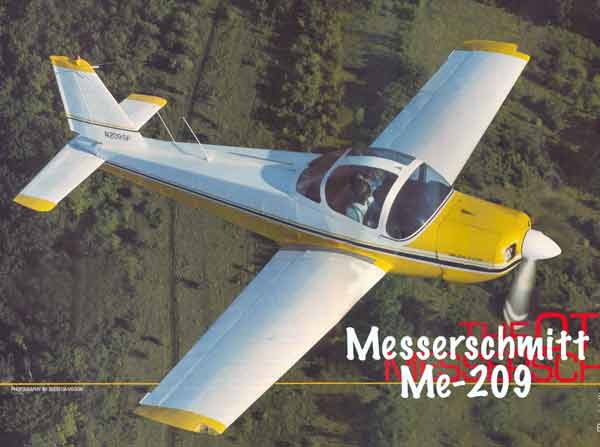
 |
MBB-209 Monsun:
Few and Far Between |
There is a well known and reasonably
overworked axiom that says “airplanes
generally fly the way they look” In otherwords, if an airplane
good, it should fly good. That, of course, is not always the case, since
there are a reasonable number of good looking airplanes that are born
turkeys. By the same token, a frumpy looking airplane is almost always
a frumpy flying airplane.
Exactly where the Messerschmitt-Boelkow-Blohm BO-209 “Monsun” fits into this collection of homolies is unknown, since it is one of the few airplanes that flies considerably better than it looks and, depending on who’s doing the beholding, is actually, not that bad looking. The plane is a curious combination of overall pleasing lines with aesthetically jarring hard corners represented by the rectangular fuselage and the “what’s-wrong with-this-picture” aspect of only having the nose gear retract. From a purely personal point of view, even though the airplanes have been in the country for nearly 20 years (the first one was imported in 1971), the Monsun is just one of those machines that never reached up and plunked the proper heartstrings. Not that I dislike them, I just sort of looked over them. It wasn't until Carl Pascarell came down from a photo mission in Al Whitaker's airplane that I began to take notice: When Pascarell sings the praises of an airplane, it's probably not a bad idea to go see what he is talking about. Whitaker's yellow and white 209 was one of the ten airplanes imported during 1971 and is unique in several aspects, not the least of which is the 180 horse Lycoming and Hartzell implanted in place of the original fixed-pitch 150 Lycoming. The plane is one of the small number of fixed gear Monsuns converted to handle a retractable nosewheel. Carl and I met Al Whitaker at Oshkosh and when Whitaker went back to Madison, Wisconsin, to continue lawyering, I gave up hope of ever sampling the airplane of which Carl thought so highly. Then, about a month later, I got a call from Art Patstone who was responding to a note I left on his airplane at Oshkosh saying he was headed east to visit some friends and wanted to know if I was interested in flying in his airplane.
Patstone, as it turns out, is something of a Monsun buff and went so far as to editing a newsletter for those ten lucky owners in the United States to aid passing along helpful little tidbits of information. In fact, in walking around his airplane at Andover Airplex Airport on an obscenely beautiful, cloud speckled Labor Day, he was dropping so many Monsun tidbits that I had to verbally sweep up after him to assemble some of the historical facts about the breed. According to Patstone, and what little information I could scrape together, there was only one production run of Monsuns supposedly totaling exactly 100 airplanes. Of those 100, 60 went to Sweden to be used as basic trainers. Ten airplanes were bundled up as part of an abortive attempt to market the airplane in the United States, but came to a screeching halt when the fickle fingers of fudged finances reached in and left a number of folks, including Messerschmitt, standing around with all the tools and jigs crated and sitting on a dock stranded while en route to central Georgia. A lot of interest was shown by various manufacturing companies, including Piper, who flew the airplane and were impressed enough to consider picking up the bits and pieces and phasing the Monsun into their line. When the boys with the calculators got done figuring what it would cost to build in this country, they threw up their hands and walked away since the 209 appeared to be a losing deal. When imported, the airplanes were selling for $14,500 which sounds like a bargain today but actually was fairly high when put against the price of a contemporary C-152 at about $10,000 and a Cherokee at about $12,500. According to the most accurate information, the manufacturers felt like it might cost as much as $18,000-$20,000 to produce the airplane, making it non-competitive in the two-place market. Those ten Monsuns were left as orphans in the country, depending upon Europe for what few parts they would need for sup-port. Among them was Patstone's airplane which was the factory demonstrator and the only one to be equipped with the 160 horse engine and the constant speed prop. Making it even more interesting, his engine is an I0-320. In other words, it has a fuel injected 160, a fairly rare Lycoming variation. Walking around the airplane with Patstone, I was being subjected to a firehose of information while my eyes tried to take in what they could of the structure. The fuselage appears unique simply because of its rectangular cross section but, if you lookreally close, the unit is unique because the rear corners of the fuselage are not as straight as they appear. For what are probably very important reasons, there is a very slight curve to all of the skins making the angles in the corners compound curves. I was beginning to understand why Piper backed away from the airplane's structure. |